Mac's Believe It or Not!
by John McDougald
Reprinted from "Crown Jewels of the Wire", October 2002, page 28
OF NATIONAL IMPORT
The editor and I have had the opportunity to visit hundreds of collectors and
collections over the past 30 years in addition to attending hundreds of
insulator shows. I have often said that I have never visited a collector or a
show without seeing an insulator that I have never seen before. Even after all
of these years, I believe that statement still holds. Believe It Or Not!
Crown Jewels of the Wire has already reported about the Fort Collins National
and the wonderful pieces that were brought to that show for "sale" and
for "show and tell." Many were pictured in the color centerfold of the
August, 2002 issue. We normally highlight the spectacular colored insulators
that come to the show in the centerfold, but collectors have been very generous
in bringing insulators that are "just a little different" so that we
can record them for posterity. The following pages show a few of the pieces that
came to the Fort Collins National that you might not have had a chance to see.
None of them will "break the bank" in terms of value, but each has a
unique feature or two that make it special for the current owner. That's part of
the continuing fascination of this wonderful hobby - even a $2 insulator can be
a prize part of anyone's collection.
First, A CD 102 Brookfield brought by Robin Harrison. Notice the unusual
marking on the back. To me, it looks like a small repair was made to the mold
(we know that there were a lot of CD 102 Brookfields made), and the repair was
held in place with a couple of grommets (or similar fastening device), hence the
two small circles in the slug plate.
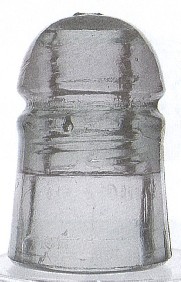 |
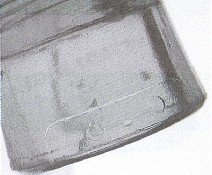 |
|
A two-grommet, slug plate mold repair on a CD 102 Brookfield. |
Next, a couple of CD 102 ponies, one in light green and one in aqua. Both
belong to James Doty and are part of his incredible CD 102 collection. I sold
the unembossed light green one to James, and he brought them for show and tell
to the National because it is the only example in his collection of an
unembossed CD 102 that looks like it came out of the same mold as the base
embossed "Patd."
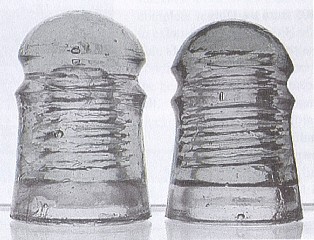
A similar mold style with a wide and shallow wire
groove would indicate that
similar molds were used.
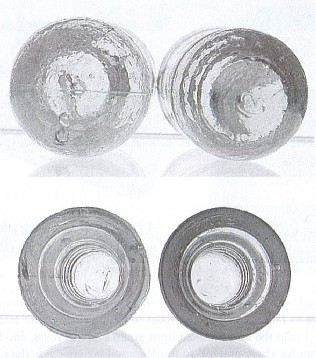
The light green one is on the left. Notice
the base embossing on the one on
the right.
Another CD 102 from the Doty collection is the H.G.W. To the best of my
knowledge, this is the only one of these that has ever been found. James
purchased it from a Texas collector several years ago, and even with the damage,
it qualifies as a very unusual piece. Its manufacturer and history remain
unknown as this time.
Paul Greaves has been spending a lot of time wandering through the hill
country of California. He told me that he had unearthed information about an old
power line that might yield some interesting glass stackers. Prior to his find,
only one complete set of these aqua bells was known to exist. Paul and Mike
Spadafora were able to salvage several sets in various conditions from this old
line. He brought the best one to the National for show and tell.
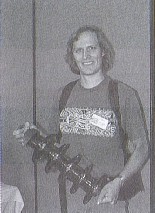
This
"stacker" consists of five CD 314 sleeves, formerly thought to have
been used as a sleeve to a pintype insulator. A great find by Paul and Mike, and
a real labor of love to haul it out of the wild all the way to Fort Collins.
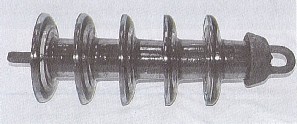
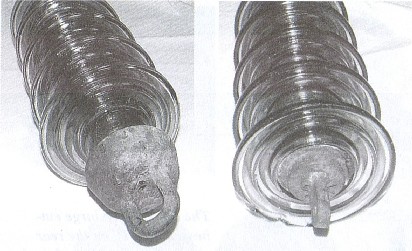
A stacker composed of "CD 314 sleeves", which will not be assigned
that number in the new Price Guide since we now know that
they are not a pintype
style.
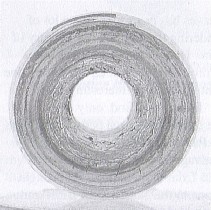 |
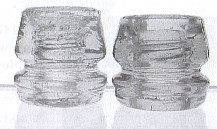 |
|
A CD 187 with a 5/8" hole on left. Standard 1" pinhole CD 187 on
the right. |
Finally, we have an innocent looking unembossed CD 187. However on closer
inspection, you may notice that the pinhole is quite small. I had a set of
calipers at the National, measured it several times, and determined that the
pinhole was 5/8" rather than the normal 1", give or take a few
millimeters. This piece wouldn't even start to thread onto a regular pin. Nathan
Lamkey brought it to the National for Jerry Mulrooney, the current owner. At
this point, we don't have any information as to its possible use or why the
pinhole was so small. BELIEVE IT OR NOT!
That's why we all keep looking.
Speaking of looking, check the following Insulators in the Air that have been
shared by the readers. . .
| 